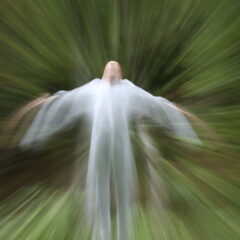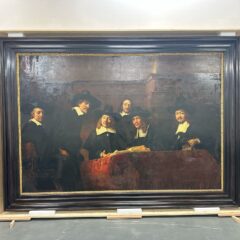Thomas Lendvai: An Interaction Between Sculpture, Space, and Self 토마스 렌드바이: 조각, 공간, 그리고 개인

The beauty of sculpture lies in the way the viewer engages in a physical relation with the spatial and temporal existence of the artwork. It challenges the long standing tradition of painting, which consists of standing and looking at a two dimensional plane hung on a wall. Sculpture, on the other hand, activates different senses and experiences. The viewer is not merely ‘viewing’ the sculpture from afar, but walks around and within the unexplored space as an active agent.
New York based artist Thomas Lendvai’s definition of art as “the thing that one takes away from an interaction with a piece of artwork” is contingent on this participatory aspect of sculpture which evokes an individual emotional phenomenon in response to the work. Lendvai’s large scale sculptures and installations creates space for self-reflection and sensing oneself within the moment.

Growing up with exposure to his father’s construction sites, Lendvai’s background in woodwork and carpentry acted as a significant artistic influence that is present in his sculptures and installations. Construction work, which mostly holds utilitarian function, necessitates consideration of how people physically navigate and experience spaces. This notion extends to Lendvai’s interest in the interactive nature of sculpture as discussed above. Using construction materials such as wood, steel, and cords molded into perfected geometric forms is something that came naturally to the artist with his previously acquired skills.
Lendvai’s initial inspiration comes from playing with elemental forms; how a line becomes a plane then a form that occupies space and so on. Such visual shift is exemplified in his piece “Eleven O’clock”. The viewer is confronted with a two dimensional line which quickly transforms to a solid trapezoid shape that becomes a thin translucent plane of red as one walks through different angles. The bright neon elastic cords hanging within the warehouse are originally used to make perpendicular lines for construction. Lendvai inverts the function of the cords by installing them at an angle to the floor but perpendicular to the slanted ceiling, placing the material and the warehouse space in conversation with each other. This subtle play on meaning immediately detaches the cords from its original context and defamiliarizes the viewer’s perception of its occupying space.

Movement is key to experiencing Lendvai’s artwork; it is not just a visual experience but also innately physical to be able to move through space in order to comprehend the full extent of his sculptures. What may initially seem like an optical illusion can be parsed out as a precise arrangement and structure of different pieces. As the viewer familiarizes themselves with the installation through this mental exercise, they experience a heightened sense of spatial awareness–as if the space opens up and is breathing.
Despite the importance of the interaction of his work and the space it occupies, the artist is hesitant about using the term ‘site specificity’. The catch-all phrase is now used to cover such a broad range of art that artists have been moving away from it. Instead, he prefers ‘site adjusting’ or ‘site responsive’ to describe the relationship between the art and space that is especially relevant during the process of installation. Lendvai would take abstract ideas developed in his studio and adjust the work around the constraints and characteristics of the given space. Quoting Richard Serra’s claim on the infamous Tilted Arc, he says that removing the work from the site would be equivalent to destroying the artwork. He describes the relationship between the artwork and space as similar to “a relationship between two people” that needs to be “compatible or meant to be.”

Installing site responsive art means having an intimate knowledge of a particular space that no one else does. From the position of lights, bumps in the wall, and imperfections in measurement, Lendvai discovers interesting ‘quirks’ of the space. “Bridge and Water” was a commission done for a friend’s loft in SoHo, where Lendvai was asked to create an installation within a functional living space that frequently held exhibits and art salons. In an attempt to bisect the empty loft space, he slid a piece of wood down the wall which unexpectedly stuck halfway down. This Eureka moment resulted in an installation of a wall sinking down from the ceiling like a giant airplane wing tilted sideways. The piece touched the wall perfectly at a single point, alluding to the touch of The Creation of Adam. The piece was not only showcased on its own, but also incorporated into other shows and performances for numerous years.
Lendvai’s more recent works consist of smaller standalone sculptures that also serve as a three dimensional sketchbook for potential scaled up installations. The artist compares this process to the game of Jenga, where he experiments with gravity and structure across different materials such as cardboard, wood, and steel. It is fascinating to imagine those sculptures, which currently fill up shelves in his studio, in a larger scale and different spatial context which would add interesting complexities to the works. But for now, Lendvai finds comfort in the process of experimentation in contrast to simply pumping out work after work, as it allows him to stop and reflect on his existential purpose as an artist that many others share. This includes contemplation of whether his art is worth pursuing anymore and what more he can make and say. Yet, despite moments of self doubt, artmaking is something Lendvai is naturally compelled to pursue. When asked about plans for future projects, Lendvai doesn’t have a definite answer; except for the fact that he will be creating as long as he feels the need to scratch his creative itch.
토마스 렌드바이: 조각, 공간, 그리고 개인

조각이 주는 매력은 관객이 작품과 물질적으로 맺는 공간적, 시간적 관계에 기반한다. 이는 벽에 걸린 평면의 그림을 서서 바라보는 것이 주류였던 회화의 오랜 전통과는 반대된다. 입체미술은 드로잉이나 페인팅에서 느낄 수 없는 다양한 감각과 경험을 활성화한다. 관객은 단순히 멀리서 조각품을 감상하는 것이 아닌, 낯선 공간 주위를 걸어 다니며 경험하는 능동적인 주체가 된다.
뉴욕에서 활동하는 아티스트 토마스 렌드바이(Thomas Lendvai)가 예술을 “개인이 작품과의 상호작용을 통해 얻는 것”이라고 정의한 것은 작품에 반응하여 개인의 주관적인 감상을 불러일으키는 조각의 참여적인 측면에 기반한다. 렌드바이의 대형 조각과 설치 작품은 보는 이로 하여금 작품과 같은 공간 안에서 존재하게 하고 상호작용을 통한 자기 성찰을 장려한다.

어렸을 때부터 아버지의 건설 현장을 도우며 자란 렌드바이의 건설과 목공에 대한 지식은 그의 조각과 설치 작품에 중요한 예술적 영감으로 작용한다. 실용적인 기능을 중요시하는 건설 작업은 사람들이 직접적으로 공간을 탐색하고 경험하는 방식에 대해 고려해야 한다. 이러한 개념은 앞서 설명한 입체작품의 인터렉티브한 특성에 대한 렌드바이의 관심으로 이어졌다. 렌드바이 작품의 특징인 완벽하게 기하학적 형태로 조각된 나무, 강철, 끈과 같은 건축 재료의 사용 또한 작가의 이전 경험에서 자연스럽게 나온 것이다.
렌드바이 작품의 초기 영감은 점, 선, 면, 그리고 공간안에 존재하는 입체 등 기본적인 조형요소를 탐구하는 것에서 비롯된다. 이러한 요소들의 관계성은 그의 작품 “Eleven O’clock”에서 잘 드러난다. 다양한 각도로 관객이 이동함에 따라 처음 마주하는 선이 붉은 사다리꼴의 형태로 바뀌고, 그 후 얇은 선으로 이루어진 면이 되는 변화를 마주하게 된다. 창고 내부에 매달려 있는 밝은 네온색 끈은 원래 수직측정을 위해 추를 매달아 사용하는 건설용 자재이다. 렌드바이는 이 끈의 기능을 반전시켜 바닥에 비스듬히 설치하되 경사진 천장에 수직으로 만나도록 배치했다. 이러한 의미의 변화는 네온 끈을 원래의 맥락에서 고립시키고 창고 공간에 대한 관객의 지각에 이질감을 부여한다.

렌드바이의 작품을 경험하는 데 있어 관객의 움직임은 작품을 온전히 이해하기 위해 필수적이다. 공간을 이동하며 감상하는 그의 작품은 시각적 경험뿐만 아니라 본질적으로 육체적 경험을 선사한다. 처음 마주할 때에는 착시 현상처럼 보일 수 있는 조각들을 분석하면 여러 부분들의 세심한 배치와 구성을 볼 수 있다. 이를 통해 작품에 익숙해지면 마치 공간이 열리고 숨쉬는 듯한 느낌과 공간에 대한 예민한 감각을 깨울 수 있다.
렌드바이 작품의 의미에서 가장 중요한 특성인 작품과 공간의 상호 작용에도 불구하고 작가는 ‘장소 특정성'(site specificity) 이라는 용어를 사용하는 것을 주저한다. 이 표현은 예전보다 광범위한 예술에 적용하여 사용되기 때문에 본래의 의미와 멀어지고 있다고 작가는 생각한다. 대신 그는 예술과 공간 사이의 관계성을 설명하기 위해 ‘site adjusting’(장소에 맞게 조정되는) 또는 ‘site responsive’(장소에 반응하는) 등의 표현을 선호한다. 렌드바이는 스튜디오에서 구상한 추상적인 아이디어를 주어진 공간의 제약과 특성에 맞게 조정하여 작품을 제작한다. 그는 리처드 세라(Richard Serra)의 악명 높은 Tilted Arc 작품에 대한 주장을 인용하여, 설치 작품을 공간에서 제거하는 것은 작품을 파괴하는 것과 같다고 했다. 렌드바이는 예술 작품과 공간의 관계를 서로 천생연분인 것처럼 맞아떨어져야 하는 연인간의 관계에 비유한다.

설치 작업을 한다는 것은 다른 누구도 알지 못하는 특정 공간에 대한 상세한 지식을 가지고 있다는 것을 의미하기도 한다. 렌드바이는 조명의 위치, 벽의 울퉁불퉁한 부분, 완벽하지 않은 측정 수치 등에서 공간의 흥미로운 특이점을 발견한다. “Bridge and Water”라는 작품은 뉴욕 소호에 있는 친구의 다락방을 위한 설치작품으로, 전시회와 아트 살롱이 자주 열리는 생활 공간에 설치물을 만들어 달라는 의뢰를 받고 만들어졌다. 렌드바이는 빈 공간을 분할하기 위해 큰 나무 조각을 아래쪽으로 밀어 넣다가 뜻하지 않게 나무조각의 모서리 부분이 벽에 끼인 것을 눈치챘다. 이 유레카의 순간은 거대한 비행기의 날개가 옆으로 기울어진 것처럼 천장에서 아래로 가라앉는 설치작품으로 이어졌다. 조각이 단 하나의 지점에서 완벽하게 벽에 맞닿은 형태는 미켈란젤로의 ‘아담의 창조’를 연상시킨다. 이 작품은 단독으로 전시되었을 뿐만 아니라 이후 수년 동안 다른 전시와 공연에도 같이 선보여졌다.
렌드바이의 최근 작품들은 대형 설치물을 위한 3차원 스케치북의 역할을 하는 작은 조형 실험들이다. 작가는 이 과정을 젠가 게임과 비교하며 판지, 나무, 강철 등의 재료로 다양한 구조와 형태가 중력에 어떻게 반응하는지를 탐구한다. 현재 스튜디오의 선반을 가득 채우고 있는 조각들이 더 큰 규모와 다양한 공간적 맥락에서 구현되면 흥미로운 작품이 탄생할 것이라고 예상된다. 그렇지만 현재로서는 렌드바이는 단순히 큰 규모의 설치작업을 쉬지 않고 진행하는 것보다는 실험하는 과정에서 예술가로서의 존재 목적에 대해 성찰하는 것에서 위안을 얻는다고 한다. 비슷한 경력의 많은 예술가들이 고민하듯 자신의 예술이 더 이상 추구할 가치가 있는지, 무엇을 더 만들고 이야기 할 수 있는지에 대한 생각이 끊이지 않는 시기이다. 하지만 의심의 순간에도 불구하고 창작은 렌드바이가 자연스럽게 추구하는 일이다. 향후 프로젝트 계획에 대한 질문에 Lendvai는 명확한 답을 내놓지 않았지만, 마치 가려운 곳을 긁고 싶은 욕구처럼 예술에 대한 갈증이 있는 한 계속 창작할 것이라는 사실만은 확실하다.







